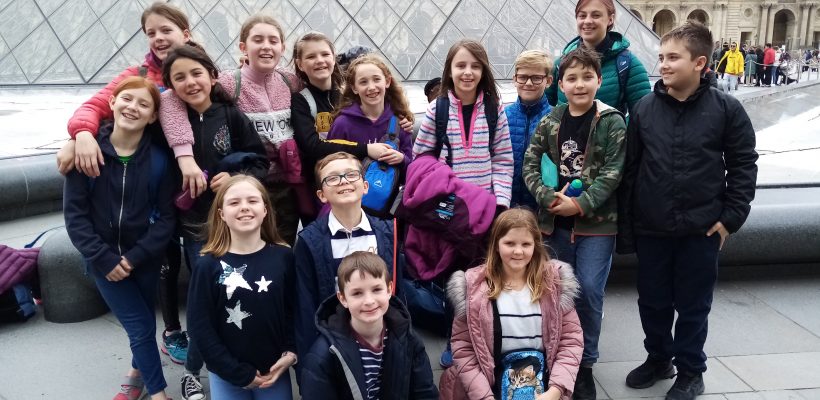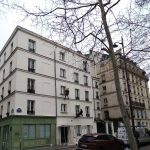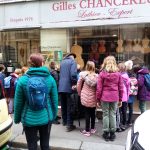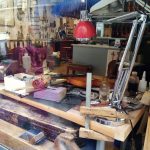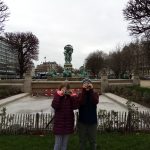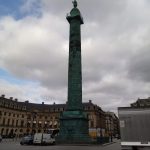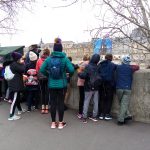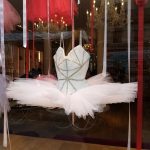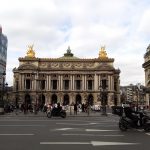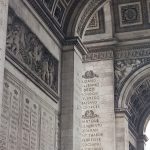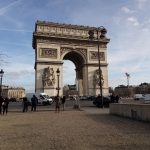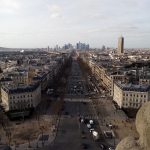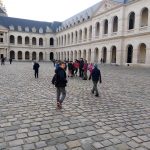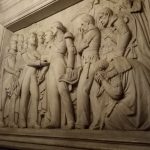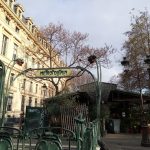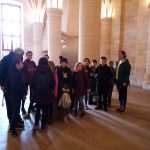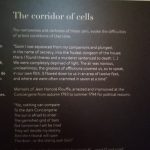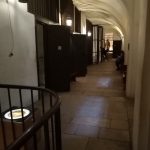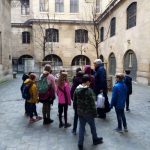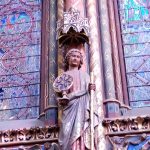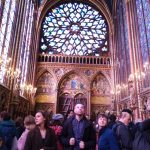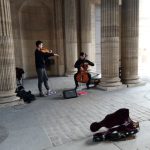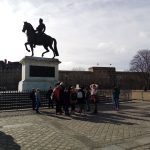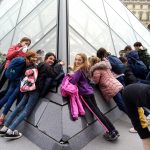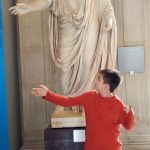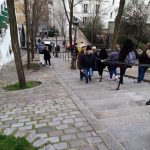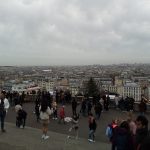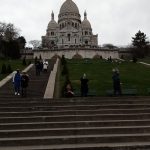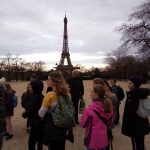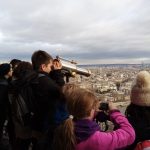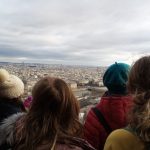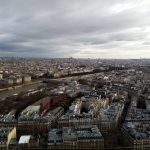Hopelands Paris Trip 2020
I thought I might write the Paris report before we left. It’s all predictable. We know the routine and we know the children.
But in truth we have no certainties. Paris is brought to a halt by a heatwave or a flood or les Gilets Jaunes or by rioting Dental Hygienists. Angelic children and the more wayward unaccountably swap roles. The race is not to the swift nor the battle to the strong, as we know. It’s about time and chance. We learn this with our own children on the day out to London, which begins all smiles and ends in the Chamber of Horrors.
The Hopelands foray got off to a fine start. The train left on time, waved off by parents who lingered on the bleak platform as their offspring headed out to the great unknown, and Swindon. I looked round the coach. Was there a dry eye amongst these children? Answers on a postcard, please.
We caught Eurostar at St Pancras and sped off to Paris. I’ve used the service virtually every year since its inception and it just gets better. And faster. In no time we were in France. Farms and houses flew by. Of course, that could have been Storm Dennis. Anyway, the children were unconcerned, as they were busy with their picnics. Hannah and Lexi munched contentedly; Oscar peered over his glasses at my humble fare. I think he was about to comment but I forestalled him by announcing that we were on the outskirts of Paris. We weren’t, but soon we were.
Our first sight of Paris reminds me how things change. The shop opposite the ticket office in the Métro is no longer the boring boutique with fresh pastries and hot croissants; it is ‘Go Johnnie Go’ offering ‘drinks and food’.
The people in the ticket office are inclined to give me the third degree about the ages of my party. Primary school children are meant to travel at half price and should one of my taller protégés surge into view there is trouble. To avoid this, I take one of the shorter ones to the counter with me, although the thought did cross my mind that Miss Porter might agree to come forward on her knees. In truth, it’s a toss-up between Amy and Matilda but I opt for Matilda as Amy appears to be in high heels. After the usual game of slamming down the window when the customer reaches the head of the queue, we buy our tickets, and I let Matilda rise from the crouching position. Then it’s off to the hotel.
Aurélie and Maria are waiting for us, which is a delight, as are the refreshments. This first evening, we usually cross Paris to the Sacré Coeur or go up the Arc de Triomphe to get our bearings high above Paris, but this time we decide to take a break and settle into our rooms before marching off to our diner for supper.
Like so much of Paris and no doubt the world, the little Matisse has been embraced by the American way – or been strangled by it. The paintings have gone and been replaced by the restaurant name in Harley Davidson lettering. The hand-thrown pizzas are no longer available, but you can have ‘un Chicken’ or ‘un Double Cheese’. Yes, there are still the hot dishes and the grilled haloumi and the fantastic salads, but it would all be pretty disappointing for me were it not for the staff who are wonderfully welcoming.
‘We heard you were here.’ says Mo.
I don’t ask how. It’s like a homecoming.
And so, to bed. Oscar and Sam have the dorm next to my room. I observe this fact to them.
‘So, you’re quite safe,’ I say reassuringly. Again, Oscar gives me one of those looks over his glasses. And I shut the door.
Friday is St Valentine’s Day and begins with an appropriately hearty breakfast, after which we buy the baguettes from Madame Thévenin who greets us enthusiastically. She shows no sign of ageing except that her eyesight isn’t what it was.
‘Oh, Monsieur,’ she beams over the counter, ‘vos enfants! Ils sont si mignons!’
It’s like one of those ‘should have gone to Specsavers’ advertisements …
Having acquired the rest of our picnic, we head off into the city, pausing for a snap in front of Natalys, with the girl herself centre stage. I thought the manager might rush out and offer to buy the photograph for company publicity. Fat chance!
Our first visit was to be the hospital at Denfert Rochereau. It’s a fine building, famous for its work for over two centuries.
‘This, I announce, ‘ – ‘
It isn’t there. The medics have left. No longer do nuns in their white cowls glide across the courtyard. Instead, coffee bars and burger joints have sprung up randomly amongst the scaffolding and cement mixers as work goes on to convert the ancient building into ‘un centre commercial’. At least there are conveniences. So they trail in, Lexi, Hannah and all, disappearing into the bowels of the gutted building.
‘All right?’ I ask when they emerge into the sunlight. ‘Did you have to pay?’
‘Yes and we should ask for our money back,’ responds Amy crisply.
We pass the catacombs. Of course, they aren’t. They are tunnels from the plaster of Paris mines. In the eighteenth century when a major reordering of the city took place and the charnel houses were emptied, they needed somewhere to stack seven million bodies. These workings seemed appropriate and one can visit this necropolis on specific days. Oddly today, St Valentine’s, was such an occasion and there were queues stretching round the block. Perhaps there is a special piquancy in plighting one’s troth beside a wall of skeletons. Max, ever curious, would have liked to take a peek but others were reluctant to wait for an hour or so to see something macabre; one can do that sitting at home watching Midsomer Murders.
We paused to learn about the Lion de Belfort. It recalls Gambetta’s escape from Paris by balloon at the end of the Franco-Prussian War. Until then, Paris had held out against the Germans after the surrender of the French armies at Metz and Sedan, tearing itself apart much as it had done in 1789. Napoleon III abdicated and sought sanctuary in England. It was an abject humiliation for a man who had endeavoured to repeat the triumphs of his great-uncle and failed at every turn. He died in Chislehurst, Kent, broken by illness and thwarted ambition. His last words were:
‘Were you too at Sédan?’
I think he was too hard on himself. The legacy of Napoleon I is the legal and administrative system of France, and the memory of glories. Napoleon III left us Paris, one of the world’s greatest, most beautiful cities. It was entirely redesigned and rebuilt thanks to his energy and vision and the ruthless brilliance of the planner, Baron Haussman. The object was to let Paris breathe and let people move about easily, enjoying the monuments and green spaces. This is Napoleon III’s triumph.
We had a glance at the Val de Grace, the scene of the Duke of Buckingham’s assignations with Anne of Austria. Joe sprang forward to take a photograph. I’m not surprised. It’s a gem of a building. Next, we wandered through the Luxembourg gardens. We could see the Panthéon through the railings. It’s a fine church, reminiscent of St Paul’s and built as a thank-offering to God when Louis XV recovered from illness. True to form he refused to foot the bill, as did the Church, and today it’s sort of pay-as-you-go basilica. The crypt contains the remains of literary and national heroes like Rousseau who coined the watchword of the Revolution, ‘Man is born free, but everywhere he is in chains.’ Actually, it’s not free to visit his tomb
The weather was perfect. The trip was going splendidly. Then tragedy struck. As we sped towards the Fountain of the Medici. Lily hurled herself to the ground. Instantly, our emergency procedures clicked in. Surgeon Commander Porter applied dressings with a dexterity, which made those long minutes in First Aid Training suddenly worthwhile. Natalie gave specialist advice. Sophie intoned the word ‘Gosh’ with deep emotion. We were a little huddle of friends gathered round a broken bird. Well, not quite. In no time at all, Lily had made a recovery – miraculous. Well, perhaps. Anyway, it seemed appropriate to stop in front of St Sulpice church for our thanksgiving picnic. The building is beautiful but odd; the south tower has remained unfinished for two hundred years because the architect, depressed at how his creation was turning out, climbed up and threw himself off the top. In recent years, the church has suffered further indignities at the hands of conspiracy theorists tricked by the Da Vinci Code into believing it is a good idea to dig up the floor with pickaxes.
There were two nice surprises here: In the magnificent fountain, mallards were swimming, two drakes on guard in the top bowl. And as we were watching, suddenly a group of students came up bearing gifts, heart-shaped lollipops for Valentine’s Day. No charge. Just pass on the message.
We follow the rue Bonaparte, the only street in Paris to bear the name. It’s full of intriguing shops but sadly Pierre Berkmann the ivory carver has gone and the shop selling original documents written by the likes of Beethoven and Molière, has also vanished. So too has my dream of turning a smart profit by offloading a genuine Harry Miles. We speed on. Sophie chatters with Grace. In these times we need grace.
After a pit-stop at the crêperie beside St Germain des Prés, we glance at Picasso’s statue of his friend Apollinaire. It’s sad that it’s so ugly but then it might be entirely accurate. Sam nodded sagely. He does that rather well, and usually has something to add. Not this time, for we were off over the Seine, seeing the Louvre for the first time and on to the rue de Rivoli. Underneath our feet was the tunnel of the catacombs where the French Resistance had their headquarters during WW II; above was the Hôtel Meurice where the Gestapo had their Paris HQ.
On we marched to the Place Vendôme. It’s where Anton Mesmer of hypnotism fame once lived. He disappeared from Paris before the Revolution. Some say he feared his association with the nobility would serve him ill in those uncertain times; others say that he became alarmed by his own extraordinary and inexplicable powers and fled to eke out his days in obscurity. That mystery aside, the square is full of interest, above all, literally, the column Napoleon erected to celebrate his victory at Austerlitz. It is a copy of Trajan’s column in Rome, and the bas-relief, made from the bronze of six hundred captured cannon, depicts his military triumph. On the top stands the man himself, in the guise of a Roman emperor. Mr Modesty he was not.
We looked at the Opéra, the architect Charles Garnier’s stunning contribution to Napoleon III’s new Paris, and then headed for the Arc de Triomphe. We nearly didn’t make it and when we finally did arrive, we were faced massive queues where pre-booking meant nothing. I sent the troops up to survey the structure whilst I conducted negotiations for the tickets. Modern France, born in the Age of Reason, is, nonetheless a place where murder is forgivable if it is ‘un crime passionnel’. So the rule is: don’t argue; just appeal to sentiment:
‘These poor children have their hearts set on this great experience. I have one little mite who was recently … involved in … (gulp) an accident.’ A tear makes its way down my grief-stricken face – the old man in the corner blows his nose loudly and two minutes later the group is climbing the monument. It’s more than Napoleon could do. The builders, ordered to construct it on this very spot, had to contend with the fact that this was the site of a vast rubbish tip, and each time they got above thirty feet or so the thing began to disappear into the mud. Indeed, when it came to the triumphal opening by Marie-Louise in 1812 they had to erect a fake arch of boarding and scaffolding for the purpose. It wasn’t finally completed for over a quarter of a century and by then Napoleon was long dead.
Our final visit of the day was to the Invalides. We didn’t tour the Army Museum, which can take a whole day but went through the complex to see Napoleon’s tomb. I think it’s a monstrous affair, which ruins a beautiful church but it is surely impressive. That’s like the mixed feelings one might have about Napoleon himself. And I do recall that Queen Victoria took her small son there and ordered:
‘Kneel down, Bertie. You are in the presence of a great man.’
Perhaps he ignored her. Perhaps he took another swipe at some passing member of the hoi polloi with his riding crop. Perhaps like a modern child he simply said. ‘Why?’ Or just perhaps he experienced that out-dated sentiment, awe.
Saturday was a good day. It started with a present from Libby, Lily and Amy, a wonderful kindness. It was also sunny again and that was a great boon.
We went by bus to the Ile de la Cité. It’s rather fun, the bus, a sort of guilty pleasure as I recounted to Company Secretary and Honorary Colonel Compton. I reminded her that Louella, Countess of Westminster said that anyone who had been on a bus after the age of thirty had ‘been a failure in life.’ Mrs Compton seemed to find that amusing – or perhaps she was noting how this applied to me.
We looked at Notre-Dame. From the far side of the square it looks much as before. It will recover. It was used as a barn during the Revolution and had become so dilapidated by the second half of the nineteenth century that Victor Hugo wrote a little thing [The Hunchback of] Notre-Dame to stir up a public demand for its restoration. Yes, Notre-Dame will arise again, the only question is in what form? We did our usual visit to the Museum of the Revolution in the Conciergerie of the old Palais Royal. Much refurbishing has taken place here and much of it diminishes the experience. The dummies dressed as guards with their quills and swords and tricorne hats, and prisoners on straw and filthy mattresses have gone. Marie-Antoinette’s cell has lost the screen over which a guard watched her night and day; it’s lost the guard; her table is gone and the letter to the Chevalier de Rougeville, pricked out with a needle to outline a plan of escape has no doubt been recycled. The original engravings of Robespierre, ‘the sea-green incorruptible’, of Danton whose mighty voice could be heard on the far side of the Seine, of mad Damien, roasted to death for his attempt to murder Louis XV fifty years earlier, all these – and everything else has been replaced by illuminated screens. Nevertheless, the troops showed real interest. Max was thoughtful, Hannah too. Libby’s pompom ears drooped, overcome with emotion.
The failure of the new arrangements in the Conciergerie has not been replicated in the Sainte Chapelle. The stained glass is still the truly glorious blaze of light and colour that it has been since St Louis commissioned the chapel as a shrine to hold Christ’s crown of thorns. Of course, the crown could be a fake but the building isn’t. Like faith, it endures. The wonder of it made Grace gasp and Joe set to with his Lumex taking his score of snaps to about the five hundred mark.
We picnicked in the Jardin du Roi where the last Grand Master of The Templars was burnt at the stake in 1415. This macabre detail does not alter the fact that it was a cheerful occasion, a good meal followed by a wild race round the lawn. I think this was won by Hannah or maybe Grace, but after a stewards’ enquiry, victory was awarded to Sam. (See Rule 49, sub-section G. on use of ear-studs).
At the Louvre, I had more trouble with the electronic world. The scanner with which the official read my documents could not identify that strange thumb-print thing which is a sort of bar code.
‘Je regrette …’ he began, shaking his head.
I wasted no time.
‘I have this injured child in my group,’ I told him, ‘and I fear …’ I shook my head. The official at the counter removed his glasses and wiped his eyes. An old man blew, his nose loudly. It was probably the same old man I had encountered at the Arc de Triomphe and probably the same nose.
Of course, the Mona Lisa – called La Joconde or La Monna Lisa by the French (logically, since her name was Madonna Lisa) – was disappointing as usual, but we’d seen it.
Outside, the Saturday ‘manifestation’ was an increasing problem. No one seemed to know what the protesters were protesting about but the gendarmes were busy blocking roads, rather randomly, it seemed to me. I think our old friend Gaston Lafarge was masterminding the operation. He recently gave up his job in the river police having failed the requisite ‘Eau’ level.
‘Jules,’ he says to his sergeant, Jules Planque, ‘ve must put up ze roadblocks.’
‘Aha,’ responds his colleague palindromically, ‘You ‘av un plan.’ He is impressed, but there’s a first time for everything.
‘Euh, not exactement,’ admits Gaston,
We were faced with the likelihood that we wouldn’t get to Les Halles, the Centre Georges Pompidou and the Hôtel de Ville as planned, so we decided to head for the Sacré Coeur. It was thus that, on the massively crowded Métro, we split into our manageable groups and sailed off. The lads and I got off at Châtelet but Miss Porter and Mrs Compton tried a different route and sped up into Montmartre. I understand Amy brought significant navigating skills to this hike. She has aspirations to join the navy, and this success might prove a winner on her CV. Meanwhile, having tried in vain to contact the errant girls’ group, we chaps were having refreshments in a nearby bar, the stools were high, and the prices higher.
And so, back to the hotel, our last night and the final day …
It was blowing a hooligan but you have to do the Eiffel Tower. Gustav has much to answer for. When we arrived, we found a new defensive glass wall around the whole base and tight security checks. Hundreds of tourists were waiting but despite the website’s claim that it opens at 9.00 tous les jours the queue only began to ease forward half an hour later. Clearly, there was now limited time but, nonetheless, all the troops rose to the challenge and led by Miss Porter and Mrs Compton, sprinted up the stairs and down again. We made it back to the hotel and on to the Gare du Nord, and finally onto Eurostar with minus three minutes to spare. Thence, it was the long trail back to London. Libby was sketching. I was allowed a peek and was impressed. Joe played chess with Harry, who looked immaculate as ever. Then it was my turn. Fortunately, I managed to fend off Joe’s wily moves until we reached St Pancras where I was forced to declare a draw.
Many of the trains from Paddington were cancelled due to the torrential rain that Britain had enjoyed in our absence, but ours left and arrived on time. We had made it, the first Hopelands Paris Trip.
The pioneers acquitted themselves well. As I said at the outset, the race is not to the swift, nor the battle to the strong. Nor, sadly, is the accolade always to the kind and the considerate, the courteous and the appreciative. Such individuals often get overlooked yet during this expedition, probably during any expedition they were the true stars. So to them, a special thank-you, and from us all, heartfelt thanks to Miss Porter and Mrs Compton. We couldn’t have managed without them.
As for our friends in Paris, they were as ever amazingly generous and welcoming; they have too the gift of making us feel that we are really doing them a favour by being there. I hope we continue to merit their warm-hearted loyalty and affection.
I believe we will.
The Hopelands Paris Party of February 2020 comprised: Oscar Coggins, Lexi Coles, Joe Dunn, Sophie Ganderton, Lily Haywood Bhatta, Grace Horrell, Matilda Huertas-Mason, Libby Hughes, Amy Jones, Sam Kennedy, Hannah Luff, Harry Miles, Natalie Pearse, Max Safizadeh with Mrs S. Compton, Miss E. Porter, Mr Martin Piper
Written by Monsieur Piper.

